Jason M. Barr February 13, 2024
[Note: Starting Monday, March 4, 2024, Gerard Koeppel and I will be co-teaching a six-week online course on the history of the Manhattan grid plan for the Gotham Center for New York City History. More information and registration can be found here.]
The Manhattan grid plan is one of New York’s most iconic elements, alongside the Brooklyn Bridge, Central Park, the Statue of Liberty, and the skyline. The grid forms a vital part of Manhattan’s identity—to walk its streets and feel its repetitive rectangles is to experience “Manhattan-ness.”
Despite being so deeply embedded—both literally and figuratively—in Manhattan Island, the grid plan retains an ongoing fascination. In this first post in a series on the grid plan, we revisit its history to see how New York set the stage that led to its world-famous street system. The following posts will document how the plan was created in 1811, how it was “installed,” and its long run impacts on New York.
Going Dutch
Manhattan as we know it began as a Dutch experiment. In 1621, the Dutch West India Company (WIC) was formed to exploit the resources of the temperate North American east coast, rife with beaver skins, timber, and optimistically grains and tobacco. Claiming the land from the Delaware River to the Connecticut River (though later reduced to the west of the Hudson), the company sought to stake its claim in the European Game of Empire. The directors enticed some French-speaking Walloon families and frontier traders to sail to America and send back its commodities.
When the settlers arrived in New York harbor, they witnessed the glorious Mannahatta—as the Lenape Indians called it—a natural wonderland abounding with fauna and flora. Its tidal estuaries were overflowing with oysters and fish. The island was covered in pine, oak, and tulip trees. Sparkling streams ran through its valleys, and marshlands swept along the coast. The Lenape had their various farming settlements and enjoyed the land’s natural bounty.
The pointy lower toe of the island, dubbed New Amsterdam, suggested itself as the place to set up shop. The tip offered a spot for defense, and thanks to the narrows pinching off the sea six miles below, the harbor waters were calm for ships laden with pelts, pines, and people.
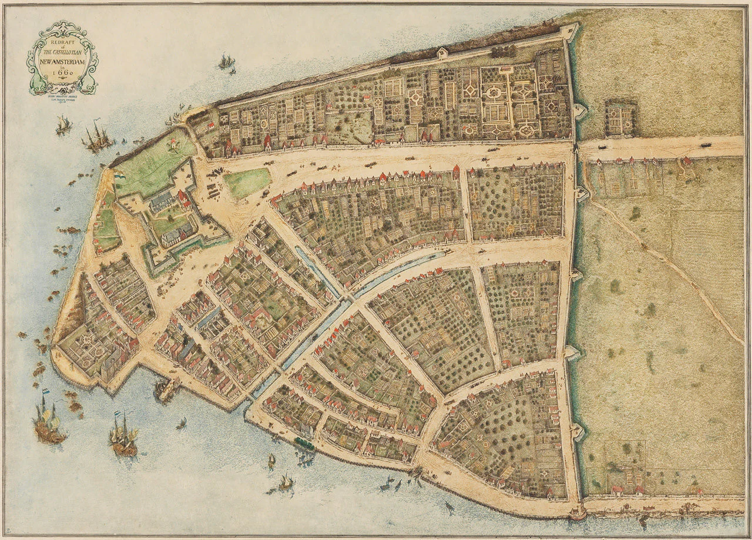
So Random
Get to work they did. The new residents quickly scattered about the place. They could not wait, nor did they care to, for any official to lay out a plan for streets and property lines. They were scrambling to make ends meet and had to improvise. Though Dutch trading ships had plied the region’s waters since Henry Hudson’s first arrival in 1609, the settlement was a new and unknown experiment.
Households took as much land as they could cultivate, and country roads connected their properties. Evidently, the WIC hired a one Kryn Frederycks to create a city plan, but he never did. The most he could muster was to design a fort, built where the Museum of the American Indian resides today.
Lower Manhattan, or let’s say “Netherhattan,” had a raw fatherland feel to it, and the Dutch quickly began to re-work the landscape to facilitate trade and commerce. The wetlands were drained, and the creaks shored up into canals. The main canal, Heere Gracht, ran along today’s Broad Street.
While we can’t say what New York would have looked like today if the Dutch had retained control, one can’t help but think it would be crossed-crossed with canals from river to river, giving the city an Amsterdam-like appearance.
Stuyvesant High
When the corporation realized that their frontier town was a mess, they sent in the dour Calvinist Peter Stuyvesant to bring order. Having fought bravely for the company against the Spanish in the Caribbean—losing a leg in the process—he was promoted to governor of the New Netherland colony.
He enacted rules left and right. One prohibited new pubs and taverns from opening without permission. Another banned the sale of firearms and alcohol to the Indians. While yet another forbade residents from allowing their hogs to roam freely. And yet another prevented drivers from speeding—in their wagons, carts, and sleighs.
When the company directors back home found that their experiment was not working out so well, they started doling out large land grants to encourage settlement and allow settlers to keep more of the proceeds. But in 1651, the directors told Stuyvesant not to grant any more freehold land unless the new owners could demonstrate they would put it to good use. In the same year, however, Stuyvesant convinced the WIC to turn over “The Great Bowery” or Farm #1 to become his large estate, from today’s East 5th Street to 17th Street, which would later be folded into the Great Grid.
In 1653, after petitions from local merchants and landholders, the company granted limited self-government for New Amsterdam, which would be comprised of a schout (sheriff/prosecutor), shepens (aldermen) and burgomasters. And while Stuyvesant and his council would constantly butt heads with the new municipal government, it set the seeds for the evolution of local governance and how the grid plan would unfold some 150 years later.
The municipal leaders didn’t have much in the way of a budget to create public works. As one Manhattan historian relates:
On June 26th [1658], the burgomasters appealed to Stuyvesant and the council for a loan to the city of ten to fifteen hundred florins, with which to repair “the City’s works as well at the City Hall as the sheet piling at the Graft [canal], etc.,” and promised “to repay it from the City revenue” at the earliest opportunity. By December 3d, the work of excavating and sheeting the graft, so as to make it accessible for small boats, was “just commenced”; but it was found that the people or their servants were throwing filth, ashes, dead animals, etc., into the ditch and “again filling up” what had been excavated. The work on the Heere Gracht (Broad Canal) was completed in 1659 and cost 2792.19 floors, which amount was levied early in 1660 on the owners of lots on both sides of the canal.
The Dutch Precedent
By the early 1660s, the Dutch created a small city of sorts with 1,500 residents, though it was not the profit paradise that the WIC had hoped for. But it held its own as a small trading town. Farms and estates ran up the rest of the island. Various hamlets and towns, like the Village of Harlem, around today’s East 120th Street, were peppered throughout. Manhattan was connected by a few long roads, such as what would become Broadway and the Boston Post Road, that followed the natural topography. A small municipal council, with limited powers, had a say over local affairs, while the company’s governor made the big decisions.

Enter the English
Empire being Empire, the British did not like the Dutch occupying what they perceived as theirs. When King Charles II was restored to the throne, he “gave” the land to his brother, James, Duke of York, who, for some unknown reason, split up his holdings, giving away to his friends the half on the western side of the Hudson River—to be called New Jersey. Little did the duke know, some three and half centuries later, his two former holdings would be fighting over congestion pricing with New Jerseyans complaining about paying twice to enter Manhattan—once for the Hudson River crossing and again for the congestion toll.
When four warships arrived in New York harbor in 1664, the Dutch burgers were promised peace. They told Governor Stuyvesant that they refused to fight. Without firing a single shot, the British ferried their officials to the fort and declared the island a Ducal Fiefdom.
The Dongan Charter
In 1686, the colonial governor, Thomas Dongan, provided the city with a new charter. It empowered a Common Council, comprising a mayor, recorder, and aldermen, representing six newly created wards. Furthermore, the charter granted the Common Council control of “All the Waste, Vacant, unpatented, and Unappropriated lands…reaching to the low watermark.” In short, whatever land and shorelines that had not previously been granted was now the property of the Common Council.
Water Lots and New York’s First Efforts at “Planning”
Since the Dutch settlers set up their own ad hoc property lines and roads, and both the Dutch and English gave out land grants for much of the rest, there was little in the way of city planning. However, one issue would remain at the fore during the colonial period and could be considered a very early form of street planning—the creation of “water lots.” In essence, the water lots were the drawing of property lines extending from the shore into the water. The City would mark off the boundaries and then sell the lots to private citizens, who were obligated to fill them to create new land.
Originally, the lots were those exposed during low tide; but over the colonial period, the Common Council gained control over more and more of the water, first extending 200 feet under the Dongan Charter and then later to 400 feet under the Montgomerie Charter issued in 1730. Lot buyers—usually those who owned the adjacent shoreland—were required to build streets and occasionally had to provide a public wharf, though they were typically allowed to erect a private pier and charge docking fees.
But as Gotham grew, the Council would see to the expansion of the shoreline in a way that provided more land and a larger port for the growing commerce. As historian Hendrik Hartog writes,
The waterlot grants made by the city allowed it to shape, control, and profit from the development of its waterfront without any obligation to finance the process….Planning through the disposal of waterlot grants by necessity would be an incremental process, dependent in every instance on private market forces.
Hartog concludes,
Clearly, the waterlots grants made by the corporation changed the face of the city. Over the last two-thirds of the eighteenth century, the harborside facilities of New York were transformed. Two full blocks were reclaimed out of the East River….Perhaps the city would have grown at the same or an even greater rate had some other form of planning or port development been in effect. It is a certainty, however, that the waterlot grants were used, as they were designed, to provide New York City with the streets, wharves, and port facilities of a growing seaport.
The Large Estates and Private Subdivisions
But as the small outpost grew, it attracted more people, and like the squeezing of a plastic ketchup bottle, the population had little place to go but north. The demand for land meant that large landholders with their mediocre-performing farms could hire a private surveyor to divide the land to sell town lots.
One early example was the roughly 17-acre area bound by Broadway, Maiden Lane, Gold, and Ann Streets, known in the 17th century as the Shoemaker’s Pasture. In 1696, the landowners subdivided the land into 164 lots. Though the blocks were not perfectly rectangular, they reveal a near grid-like pattern and were subdivided into roughly 25’ x 125’ foot lots, most with north-south orientations.
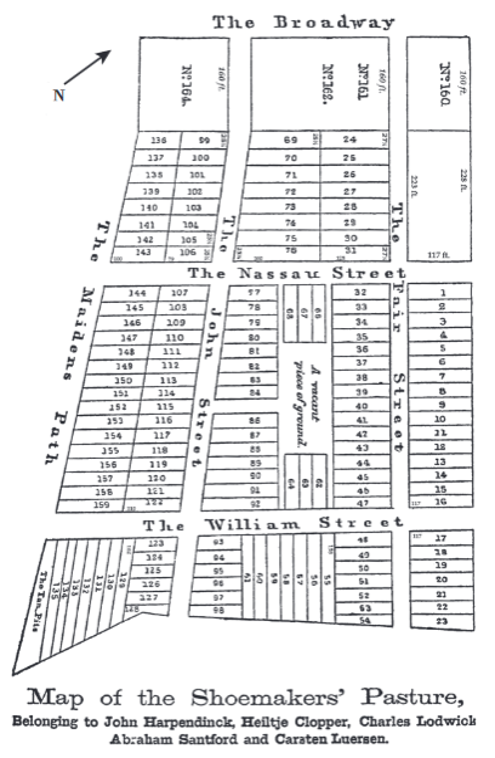
In 1741, Lieutenant Governor James De Lancey purchased a 340-acre farm on the lower east side of Manhattan. His son, James De Lancey, surveyed the land and mapped it into blocks with potential building lots. As historian Elizabeth Blackmar writes, “A 1766 city plan shows the farm laid out with ‘De Lancey Square,’ reminiscent of London’s Georgian residential squares, at its center.” However, when the Revolution came, because the De Lancey’s were loyalists, their land was confiscated by New York State. When later surveying the land for sale, the state preserved De Lancey’s plan but eliminated the large square. Houses, in this case, were given an east-west orientation.
Another example is that of Trinity Church, which was granted large tracts of land by the crown. In the 1750s, the church laid out a portion of land between Broadway and the Hudson River into a small neighborhood of several rectangular blocks around the newly formed Kings College at the town’s north edge, west of today’s Church Street. It was one the earliest examples of a private landlord imposing a grid formation on Manhattan.
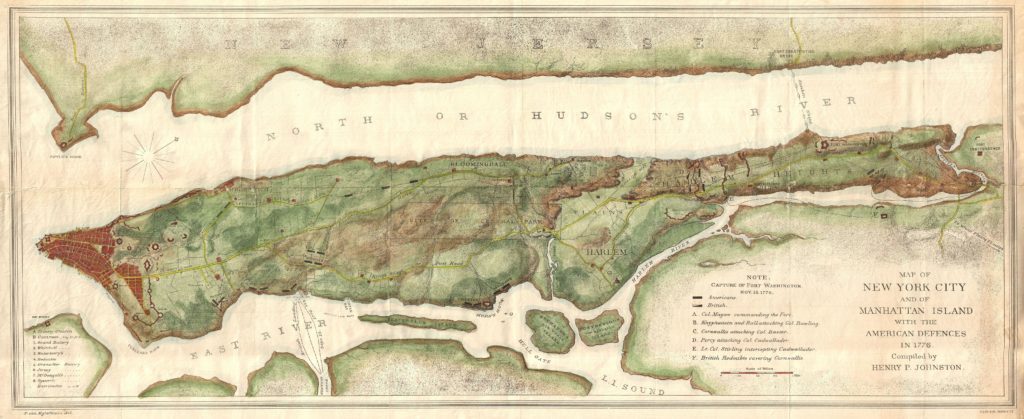
The American Experiment
The War of the Dueling Georges, a/k/a the American Revolution, led to the new republic. And like that, the small city on the Hudson had to figure out what to do with itself. However, the historical rights given to those with private property combined with the Common Council’s limited powers meant there were bounds on what could be done in terms of planning.
The municipality was run by the landed wealthy to improve the lives of the landed wealthy, who were the citizens or “shareholders” of the municipal corporation. “Property rights and civil or individual rights,” Hertog reveals, “could not be placed in opposition to one another. They were of a piece and conceptually identical. It was the quality, the permanence, and the security of an individual’s property rights that gave him political significance.”
The Common Lands
But the Common Council did own 1,300 acres originally granted by the Dongan Charter, called the Common Lands, along the spine of Manhattan. The land ran from about today’s 23rd Street to Harlem, and from about Second Avenue to Seventh Avenue. The land was rocky and rugged and of little use for farms. Today, it comprises a hearty chunk of Central Park. The municipality aimed to raise money to refill its coffers after the war and hoped to sell the land.
In 1785, the Common Council hired the surveyor Casimir Theodor Goerck to map and subdivide the land. His instructions were to create large parcels of five acres. For access, Goerck placed one main road up the middle. But after platted, there were few takers, and sales were shelved.
In 1794, the Councillors turned again to Goerck to make an updated Commons Lands map. He added two more north-south avenues on the edges. Furthermore, he made each block perfectly rectangular to form a gridiron plan. But to keep the five-acre requirement, each of the lots was arranged so the length ran east-west about 866 feet and with a north-south width of about 264 feet (sound familiar?). This time, the city’s growth seemed more promising, and the sales generated revenue.
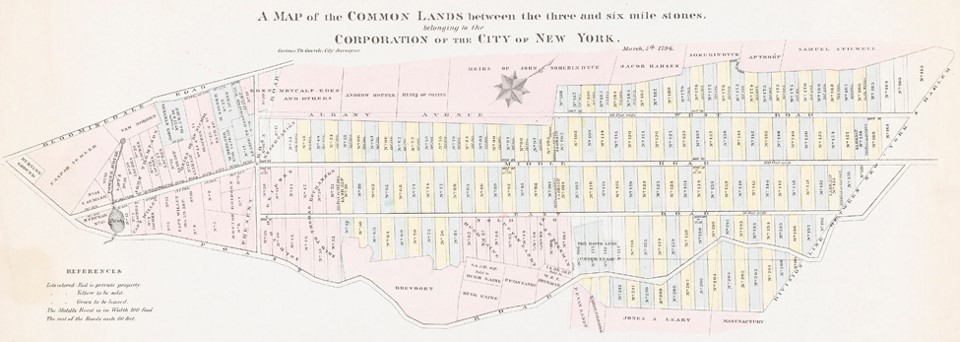
The Mangin Plan
In 1797, the City took another step toward planning—this time, surveying and mapping the city itself. The Common Council hired a French émigré named Joseph Mangin to create New York’s first official map since the Revolution. Magnin teamed up with Goerck for the effort.
Together, as grid plan historian Gerard Koeppel writes, “[T]he Mangin-Goerck map would offer greater breadth and depth than any previous map of the city and its outlying regions.” In 1798, Goerck succumbed to Yellow Fever, likely from a mosquito bite while out surveying. Mangin proceeded alone and began to alter the plan to his liking, providing not a map of the city as it was but a plan of what he thought it should be.
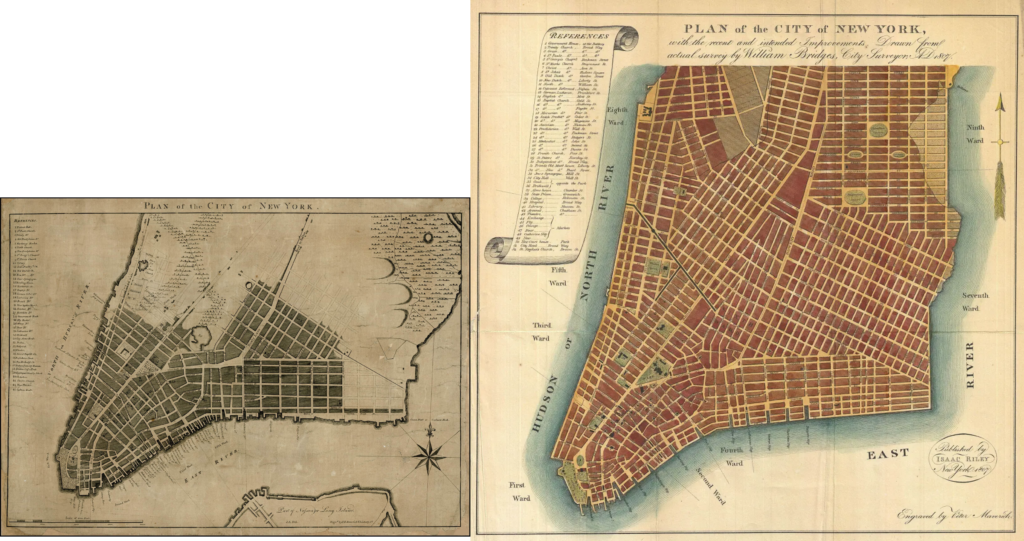
Mangin’s plan of 1803, Koeppel finds,
was remarkable in two ways. Mangin had idealized the city proper, in particular by enlarging the island’s tip and smoothing the irregular waterfront with blocks of river landfill and new streets….Bolder still was Mangin’s vision for the island beyond the settled city limits….Here, where there were only farms, homesteads, and undeveloped land, he mapped out numerous segments of the rectilinear grid….In the irregular meeting of the various grid segments were countless opportunities for small parks, prominent buildings, or other urban display or public space. Linking everything were numerous north-south roads…It was a layered picture of order and ornament, urban function and natural form: the complexity and grade of a European capital adapted to the limits of a narrow island.
As brash and bold was his vision, it was not his time. Mangin’s plan ran into opposition in the Common Council, and it was scrapped. Though, like Casimer Goerck’s plan for the Common Lands, it would hover in ether.
The Future to Come
However, a few things were evident at the dawn of the 19th century. The small city at the tip of Manhattan had gnarly, twisted streets that made the smooth functioning daily life difficult. And, to the north, as populations grew, landholders were subdividing their lots based on their own interests and prerogatives. Though much more grid-like and rational than the city to the south, there was little coordination.
Since the city’s growth was assured, the time was ripe for a greater, bolder vision that allowed the municipal government to take control of the situation and map out avenues, streets, and blocks to create a property city. It would need a street plan for real.
And to this history, we will turn next in Part II of the blog post series.
[…] owners for improvements on and around their property was an age-old tradition that went back to the Dutch and British colonial days as well. After the Civil War, as the city’s government became larger and more “governmental,” […]